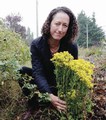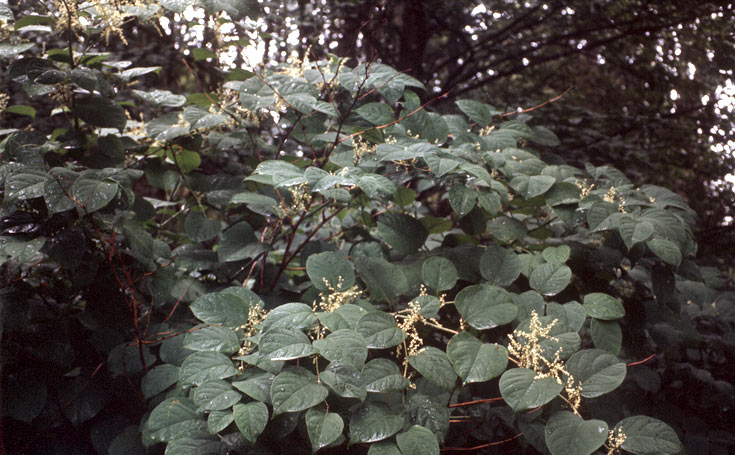A Regional Team Approach: Four Local Governments Collaborate to Tackle Invasive Knotweed in the Comox Valley
Note to Reader:
Since 2008, the Comox Valley has been a provincial demonstration program for what is branded as a ‘regional team approach’ in the local government setting. The current program to eradicate invasive knotweed provides an on-the-ground example of what can be accomplished through collaboration when there is a shared vision of a desired outcome.
Knotweed – One of the World’s Worst Invaders
Knotweed is considered one of the world’s worst invaders. This hollow stem shrub (which resembles bamboo), can destroy fish and wildlife habitat, penetrate pavement causing damage to infrastructure such as roads, walls and drainage systems. In the United Kingdom, Japanese knotweed has grown rampant, causing severe financial implications, including mortgages refused on properties with knotweed.
Cutting, mowing, and pulling stimulate shoot growth and may cause roots to spread further resulting in new infestations up to 20 metres away. As well knotweed has the ability to regenerate from a very small root or stem fragment and can remain dormant for many years. This is especially problematic when growing near riparian areas as the fragments can enter the waterway and regenerate further downstream.
Comox Valley Regional Program
A regional program launched in 2013 and aimed at reporting and eradicating invasive knotweed species from the Comox Valley was so successful in finding and treating select knotweed locations, that this year the program has expanded to include all four local governments (Town of Comox, City of Courtenay, Village of Cumberland and the Comox Valley Regional District (CVRD).
This program is in partnership with the Coastal Invasive Species Committee (Coastal ISC) and is asking the public to report sightings of knotweed. The program aims to verify all knotweed reports within the Comox Valley and to provide professionals to conduct treatments on select sites.
 “Knotweed is a bully in the plant world. It’s an invasive and aggressive plant that spreads easily and can impact property values, the environment and cause safety issues on roadways. Look for the Knot on My Property program on our website or pick-up a booklet from any four local governments to learn more ways to defend your property from invasion” explains Rachelle McElroy, Executive Director of the Coastal ISC.
“Knotweed is a bully in the plant world. It’s an invasive and aggressive plant that spreads easily and can impact property values, the environment and cause safety issues on roadways. Look for the Knot on My Property program on our website or pick-up a booklet from any four local governments to learn more ways to defend your property from invasion” explains Rachelle McElroy, Executive Director of the Coastal ISC. “This is a great opportunity to work with our local governments region-wide to proactively implement the treatment of knotweed species,” said Edwin Grieve, Comox Valley Regional District board chair. “As it is expensive and difficult to control once it is fully established, this is a cost-effective means to gain effective control before that happens.”
“This is a great opportunity to work with our local governments region-wide to proactively implement the treatment of knotweed species,” said Edwin Grieve, Comox Valley Regional District board chair. “As it is expensive and difficult to control once it is fully established, this is a cost-effective means to gain effective control before that happens.”
Benefit of a Regional Team Approach
“Collaborating on the Knotweed program was pretty straightforward in our context. Cumberland and the Comox Valley Regional District had already partnered the year before  and it was easy for Courtenay and Comox to build on their past work,” reports Nancy Hofer, Environmental Planner with the City of Courtenay. She is also represents the City of the Comox Valley-CAVI Leadership Team. (CAVI is the acronym for Convening for Action on Vancouver Island; and is an initiative of the Partnership for Water Sustainability in British Columbia).
and it was easy for Courtenay and Comox to build on their past work,” reports Nancy Hofer, Environmental Planner with the City of Courtenay. She is also represents the City of the Comox Valley-CAVI Leadership Team. (CAVI is the acronym for Convening for Action on Vancouver Island; and is an initiative of the Partnership for Water Sustainability in British Columbia).
“Now all four governments can benefit from the single education effort that is occurring, and all residents in the Valley are aware that their local governments take the issue seriously, regardless of what jurisdiction the knotweed falls within. We expect that this coordinated messaging will result in higher awareness and willingness to allocate resources to the topic for future years, thereby growing the program.”
“In small rural communities such as ours this is the type of program that relies on collaboration for success,” concludes Nancy Hofer.
To Learn More:
A knotweed alert sheet, providing information on identification, proper disposal, and reporting options has been developed and is available on the CVRD website at www.comoxvalleyrd.ca/invasiveplants.
For more information on identification of this plant and its damaging impacts, visit: http://www.coastalisc.com and click on the “Invasive Species” tab.



